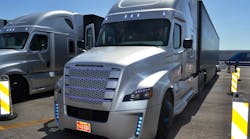WASHINGTON. Over the next decade or so, policymakers project the world will look dramatically different as advances in automation will bring fully autonomous cars and commercial vehicles to the country’s roadways.
But what will that mean for the U.S. workforce – particularly the truck drivers who move our freight from point A to point B?
Securing America’s Future Energy (SAFE) hosted a summit Wednesday to discuss its latest report America’s Workforce and the Self-Driving Future: Realizing Productivity Gains and Spurring Economic Growth. The report delves into the potential economic and social benefits of self-driving technologies. It also looks at the potential timing and impacts to the American workforce.
The report found that by 2050, autonomous vehicles (AVs) will add between $3 trillion to $6 trillion in cumulative consumer and societal benefits to the U.S. economy. Annually, $800 billion in economic and societal benefits could be realized when AVs are fully deployed, according to SAFE.
During a panel discussion of the report’s findings, Susan Helper, former chief economist for the U.S. Department of Commerce, noted that with full adoption of AVs comes the potential for increased job inequality issues. That is especially relevant for industries like trucking, which is dealing with a shortage of around 50,000 drivers and an aging workforce.
“I think this is a great case of where we could see a really positive future or a really negative future,” Helper explained. “The positive future would be where truck driver jobs are way better, you don’t need as many of them, and people don’t have to be separated from their families. But you could also imagine a kind of negative future where vehicle miles traveled and where congestion could actually go up.”
Although AVs are said to be more efficient, Helper noted some studies suggest that vehicle miles traveled could increase as much as 80% with self-driving vehicles.
“You could see far more congestion and it could in fact mean that the trucks that remain staffed will spend more time in those traffic conditions,” she added. “That means instead of being able to take advantage of some of the benefits of not paying attention [to road conditions], workers will have to work longer hours.”
Panelist Erica Groshen, former commissioner of the Bureau of Labor Statistics, pointed out that going forward truck driver vacancies, wages and working conditions have to be taken into consideration when discussing AVs.
“While there is never a clear smoking gun in these circumstances, those sorts of situations that have existed for a long time suggest the presence of a monopsony in that market, which is when employers have a great deal of control more than the control they would have in a competitive market situation,” Groshen said. “If that’s the case, then you particularly have to have concern of how this will play out for the truckers. There are some good scenarios for them, but there are also the scenarios that this is just an opportunity for the working conditions to actually get worse and the wages to actually get worse for the workers.”
New legislation called the AV START Act is the first federal framework for self-driving technology. Senator Gary Peters (D-MI), cosponsor and lead author of the bill, stressed the importance of moving quickly on federal regulations for AVs because of the rapid changes in technological advances.
The bill creates a framework for grants and waivers and includes mandatory safety requirements for AVs. Peters also emphasized that moving forward, policymakers must ensure AVs are hardened for cyberattacks, and that data can help determine how these vehicles perform in the real world on public highways.
Consumer education also is part of the bill, and with that, Peters mentioned lawmakers need to tackle the misconception that AVs will eliminate jobs.
“We have to be prepared as a society to understand that the jobs are going to be different,” Peters noted. “They can be better; they can be qualitatively better. It’s going to require the ability to understand how these machines work and put a human with a machine together.”
“I’m not a job apocalypse guy to think that all the jobs are going to disappear, and [the SAFE] report confirms that,” he continued. “The one thing that I am concerned about is that we could see an increase of income inequality and a widening of the gap and a hollowing out of the middle class in this process. And that is a significant threat not just to the economy in this country, but to our very core democracy as well, which is why we have to transform how we’re training people. The education system that worked in the last century is not going to work for this century and we have to start there.”




